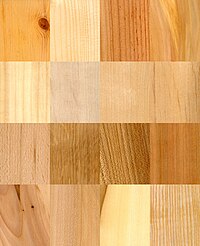
Photo from wikipedia
Chenshan red-heart Chinese fir is a provenance of Cunninghamia lanceolata, with high-value red heartwood, which is widely used in high-quality furniture and construction. Yet, there is still little information on… Click to show full abstract
Chenshan red-heart Chinese fir is a provenance of Cunninghamia lanceolata, with high-value red heartwood, which is widely used in high-quality furniture and construction. Yet, there is still little information on heartwood development of this tree for high-value decorative timber, which is essential to improve one's plantation management strategy. Here, we investigated the horizontal and vertical variation of heartwood and sapwood and simulated heartwood formation process using stem analysis method. We selected 15 sample trees from five plots of 20 m × 30 m in Chenshan red-heart Chinese fir plantations (9, 15, 26, 29, and 34 years old, respectively). The results showed that Chenshan red-heart Chinese fir stems began to form heartwood when the xylem diameter reached 4 to 8 cm. The heartwood diameter and area, as well as the sapwood area, all increased in the different-aged Chenshan red-heart Chinese firs with increasing xylem diameter and decreased with increasing tree height. As tree height increased, the red heartwood formation rate declined at all ages. Relationship analysis showed that xylem diameter was the most important factor influencing heartwood formation. Red heartwood rate at breast height could be modeled by logistic models. We concluded that heartwood formation began at about 7 years old, and the formation rate increased until peaking at 60 percent at 40 years old. In conclusion, it will be imperative to prolong the Chenshan red-heart Chinese fir rotation period from the currently common 25 years to about 40 years to achieve the maximum sustainable yield of high-value decorative timber.
Journal Title: Forest Products Journal
Year Published: 2021
Link to full text (if available)
Share on Social Media: Sign Up to like & get
recommendations!